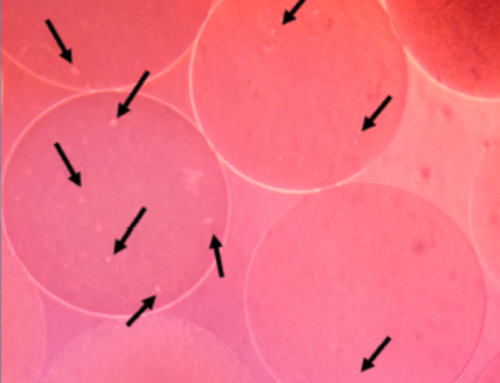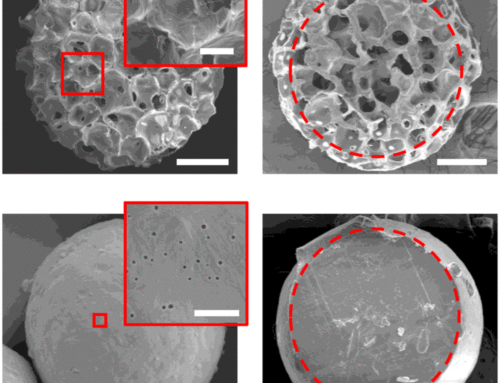The Science Behind Cell–Material Interactions
In large-scale cell culture and regenerative medicine, microcarriers are essential for expanding adherent cells in suspension bioreactors. A 2025 study in the Chemical Engineering Journal by Tian et al. revealed that the mechanical stiffness of these carriers directly influences how human amniotic epithelial cells (hAECs) grow and maintain their identity — reshaping how we think about scalable, high-quality cell culture.
A Quick Look at hAECs
Key Findings: Softer Microcarriers, Healthier Cells
The researchers created biopolymer-based microcarriers with three stiffness levels:
- Soft (~0.15 MPa) — mimicking the native amniotic membrane
- Medium (~1.86 MPa) — similar to common commercial carriers
- Stiff (~8.57 MPa) — representing rigid culture surfaces
Although surface chemistry was identical, stiffness alone changed cell behavior:
- Soft microcarriers produced the highest proliferation and preserved epithelial morphology and markers (E-cadherin, EpCAM).
- Medium-stiff carriers supported moderate growth but showed early epithelial-to-mesenchymal transition (EMT).
- Stiff carriers reduced proliferation and triggered full EMT, with fibroblast-like shapes and higher CD90 and vimentin.
hAECs expanded about 28× on soft, 15× on medium, and 8× on stiff carriers, compared with 3.8× on standard 2D plastic — a clear stiffness-dependent effect.
Why Stiffness Changes Cell Behavior
The study showed that stiffness alters how hAECs remodel their own extracellular matrix (ECM) and communicate through integrin and Wnt/β-catenin pathways.

Why Stiffness Matters for Every Cell Type
Each cell type has its own mechanical “sweet spot.”
| Cell Type | Optimal Stiffness (MPa) | Outcome |
| Epithelial / stem-like cells (hAECs, ESCs) | 0.1 – 1 | Preserves phenotype & prevents EMT |
| Mesenchymal / fibroblast cells | 1 – 5 | Supports adhesion & differentiation |
| Industrial / robust lines | > 5 | Provides stability in bioreactors |
Choosing the right stiffness improves yield, reproducibility, and product quality.
Why Choose Smart MCs Microcarriers
Smart MCs Microcarriers are designed to provide researchers with precise control over their culture environment.
Each batch can be tailored to suit different cell types and process requirements, ensuring consistent and reliable performance across applications.
Customisable Features
-
Tunable stiffness: adjustable from 3 kPa to 100 kPa to match native tissue mechanicsSurface chemistry: modify surface charge or apply specific coatings to enhance cell attachment or signalling
- Size and density: available in various particle sizes for different bioreactor configurations
- Dissolvability options: choose between fully dissolvable (TrypLE or Trypsin) and non-dissolvable microcarriers depending on process needs
- Bioreactor compatibility: suitable for spinner flasks, wave-bags, and stirred-tank systems
Smart MCs Microcarriers provide flexibility in design, enabling researchers to fine-tune their culture systems for optimal cell attachment, proliferation, and recovery.
Buy microcarriers or contact us to discuss a stiffness profile tailored to your cell line.
Reference
Tian, J., Hao, W., Li, J., Na, X., Wang, S., Wei, W., Lu, Y., Cui, Y., Zhang, W., He, Z., Ma, G., & Zhou, W. (2025). Microcarrier stiffness controls human amniotic epithelial cells (hAECs) proliferation and epithelial-mesenchymal transition (EMT) via remodeling ECM and Wnt/β-catenin pathway. Chemical Engineering Journal, 507, 160558. https://doi.org/10.1016/j.cej.2025.160558
Disclaimer
This blog summarises findings from Tian et al., Chemical Engineering Journal (2025) to highlight the scientific importance of microcarrier stiffness. The study did not use Smart MCs microcarriers or involve Smart MCs in any way. References to Smart MCs products are included only to illustrate how these research principles are applied in our customisable microcarrier designs.











Leave A Comment